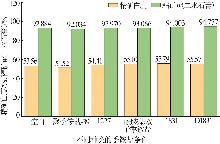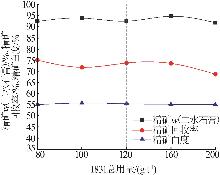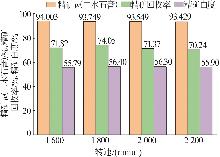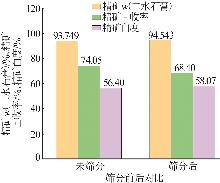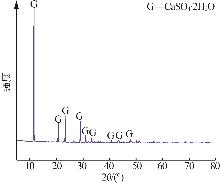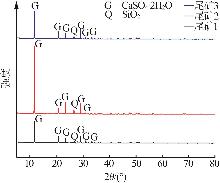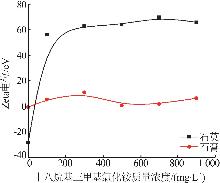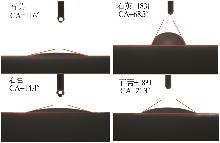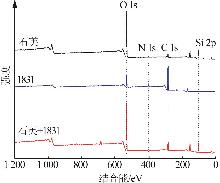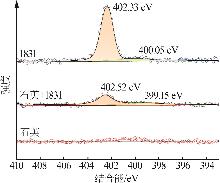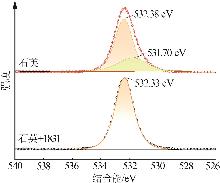Inorganic Chemicals Industry ›› 2025, Vol. 57 ›› Issue (4): 111-117.doi: 10.19964/j.issn.1006-4990.2024-0356
• Environment·Health·Safety • Previous Articles Next Articles
Study on purification of phosphogypsum by reverse flotation of octadecyl trimethyl ammonium chloride and its removal mechanism of quartz
ZHAO Mengyan1( ), CHEN Junwu2, WANG Xun2, WEI Na1, WENG Xiaoqing1(
), CHEN Junwu2, WANG Xun2, WEI Na1, WENG Xiaoqing1( ), CHEN Yingxin1
), CHEN Yingxin1
- 1. Wuhan Institute of Technology,Wuhan 430074,China
2. Hubei Yihua Group,Yichang 443000,China
-
Received:2024-06-25Online:2025-04-10Published:2025-04-21 -
Contact:WENG Xiaoqing E-mail:1693356833@qq.com;xiaoqingw@163.com
CLC Number:
Cite this article
ZHAO Mengyan, CHEN Junwu, WANG Xun, WEI Na, WENG Xiaoqing, CHEN Yingxin. Study on purification of phosphogypsum by reverse flotation of octadecyl trimethyl ammonium chloride and its removal mechanism of quartz[J]. Inorganic Chemicals Industry, 2025, 57(4): 111-117.
share this article
Table 2
Results of phosphogypsum sieve analysis test"
| 粒级/μm | 产率/% | w(CaSO4· 2H2O)/% | 回收率/ % | 白度/ % |
|---|---|---|---|---|
| >297 | 0.37 | 24.576 | 0.11 | 20.10 |
| 178~297 | 2.25 | 73.292 | 1.97 | 21.87 |
| 150~<178 | 7.98 | 93.975 | 8.88 | 40.88 |
| 106~<150 | 18.95 | 92.793 | 20.81 | 43.12 |
| 74~<106 | 26.52 | 93.558 | 29.37 | 54.31 |
| 48~<74 | 23.99 | 92.882 | 26.38 | 55.32 |
| 38~<48 | 4.31 | 85.641 | 4.37 | 51.03 |
| 18~<38 | 3.19 | 68.900 | 2.60 | |
| <18 | 12.44 | 37.464 | 5.51 | 20.11 |
| 原矿 | 100 | 84.467 | 100 | 21.01 |
Table 3
Binding energy and concentration change of XPS atoms on quartz surface before and after treatment with octadecyl trimethylammonium chloride"
| 元素 | 石英 | 石英+1831 | 偏移量 结合能/eV | |||
|---|---|---|---|---|---|---|
结合能/ eV | 原子 数分数/% | 结合能/ eV | 原子数 分数/% | |||
| C 1s | 284.80 | 16.42 | 284.72 | 23.64 | -0.08 | |
| O 1s | 532.02 | 58.34 | 532.06 | 50.61 | 0.04 | |
| N 1s | 402.00 | 1.43 | ||||
| Si 2p | 102.82 | 25.24 | 102.88 | 24.32 | 0.06 | |
| [1] | ATTALLAH M F, METWALLY S S, MOUSSA S I,et al.Environmental impact assessment of phosphate fertilizers and phosphogypsum waste:Elemental and radiological effects[J].Microchemical Journal,2019,146:789-797. |
| [2] | CICERI D, ALLANORE A.Local fertilizers to achieve food self-sufficiency in Africa[J].Science of the Total Environment,2019,648:669-680. |
| [3] | SILVA L F O, OLIVEIRA M L S, CRISSIEN T J,et al.A review on the environmental impact of phosphogypsum and potential health impacts through the release of nanoparticles[J].Chemosphere,2022,286:131513. |
| [4] | 徐长忠,於金浩,李义连.磷石膏的预处理和综合利用研究进展[J].安全与环境工程,2024,31(1):260-270. |
| XU Changzhong, YU Jinhao, LI Yilian.Research progress of pretreatment and comprehensive utilization of phosphogypsum[J].Safety and Environmental Engineering,2024,31(1):260-270. | |
| [5] | 刘梅,高利坤,何海洋,等.磷石膏杂质脱除、稀土回收及资源化利用研究进展[J].化工矿物与加工,2023,52(10):24-31. |
| LIU Mei, GAO Likun, HE Haiyang,et al.Research progress in removal of impurities and recovery of rare earth from phosphogypsum and its resource utilization[J].Industrial Minerals & Processing,2023,52(10):24-31. | |
| [6] | 朱桂华,何宾宾,杨文娟,等.磷石膏净化技术研究进展[J].磷肥与复肥,2023,38(4):25-30. |
| ZHU Guihua, HE Binbin, YANG Wenjuan,et al.Research progress of phosphogypsum purification technology[J].Phosphate & Compound Fertilizer,2023,38(4):25-30. | |
| [7] | 张利珍,吕子虎,张永兴,等.磷石膏提质降杂实验研究[J].无机盐工业,2021,53(6):171-173,184. |
| ZHANG Lizhen, Zihu LÜ, ZHANG Yongxing,et al.Experimental study on improving quality and reducing impurity of phosphogypsum[J].Inorganic Chemicals Industry,2021,53(6):171-173,184. | |
| [8] | FANG Ji, GE Yingyong, CHEN Zhijie,et al.Flotation purification of waste high-silica phosphogypsum[J].Journal of Environmental Management,2022,320:115824. |
| [9] | QI Mengyao, PENG Weijun, WANG Wei,et al.Simple and efficient method for purification and recovery of gypsum from phosphogypsum:Reverse-direct flotation and mechanism[J].Journal of Molecular Liquids,2023,371:121111. |
| [10] | 邓伏礼,夏志祥,龙秉文,等.磷石膏反浮选提纯工艺研究[J].无机盐工业,2024,56(5):115-120. |
| DENG Fuli, XIA Zhixiang, LONG Bingwen,et al.Study on purification process of phosphogypsum by reverse flotation[J].Inorganic Chemicals Industry,2024,56(5):115-120. | |
| [11] | 陈小红,余意,朱淼,等.磷石膏共反浮选除杂增白工艺研究[J].无机盐工业,2024,56(10):86-94. |
| CHEN Xiaohong, YU Yi, ZHU Miao,et al.Study on co-reverse flotation process of phosphogypsum for impurity removal and whitening [J].Inorganic Chemicals Industry,2024,56(10):86-94. | |
| [12] | 史皓东,曾彦琦,任浏祎,等.磷石膏共反浮选脱色提质工艺及机理研究[J].非金属矿,2024,47(2):97-102. |
| SHI Haodong, ZENG Yanqi, REN Liuyi,et al.Decolorization and quality improvement process of phosphogypsum by co-reverse flotation and its mechanism[J].Non-Metallic Mines,2024,47(2):97-102. | |
| [13] | 张晗.苄基季铵盐对磷石膏浮选脱硅性能与作用机理研究[D].郑州:郑州大学,2022. |
| ZHANG Han.Study on performance and mechanism of benzyl quaternary ammonium salt for desilication of phosphogypsum [D].Zhengzhou:Zhengzhou University,2022. | |
| [14] | ZHANG Han, CHAI Wencui, CAO Yijun.Flotation separation of quartz from gypsum using benzyl quaternary ammonium salt as collector[J].Applied Surface Science,2022,576:151834. |
| [15] | 严超,彭秋桂,朱淼,等.磷石膏综合利用及除杂方法综述[J].磷肥与复肥,2023,38(2):27-33. |
| YAN Chao, PENG Qiugui, ZHU Miao,et al.Comprehensive utilization and impurity removal methods of phosphogypsum[J].Phosphate & Compound Fertilizer,2023,38(2):27-33. | |
| [16] | 姜威,龚丽,何宾宾,等.磷石膏脱硅试验探索[J].云南化工,2019,46(12):125-127. |
| JIANG Wei, GONG Li, HE Binbin,et al.Experimental study on desilication of phosphogypsum[J].Yunnan Chemical Technology,2019,46(12):125-127. | |
| [17] | LIU Wenbao, LIU Wengang, WEI Dezhou,et al.Synthesis of N,N-Bis(2-hydroxypropyl)laurylamine and its flotation on quartz [J].Chemical Engineering Journal,2017,309:63-69. |
| [18] | GUO Wenda, ZHU Yimin, HAN Yuexin,et al.Flotation performance and adsorption mechanism of a new collector 2-(carbamoylamino) lauric acid on quartz surface[J].Minerals Engineering,2020,153:106343. |
| [19] | YANG Siyuan, PENG Tiefeng, LI Hongqiang,et al.Flotation mechanism of wolframite with varied components Fe/Mn[J].Mineral Processing and Extractive Metallurgy Review,2016,37(1):34-41. |
| [20] | 宋水祥.胺类捕收剂对赤铁矿和石英浮选行为及其泡沫稳定性的影响[D].昆明:昆明理工大学,2020. |
| SONG Shuixiang.Effect of amine collectors on flotation behavior and foam stability of hematite and quartz [D].Kunming:Kunming University of Science and Technology,2020. | |
| [21] | MATHEW R T, COONEY R P, MALMSTROM J,et al.Atomic force microscopy and angular-dependent X-ray photoelectron spectroscopy studies of anchored quaternary ammonium salt biocides on quartz surfaces[J].Langmuir,2018,34(16):4750-4761. |
| [22] | ZHANG Qian, WEN Shuming, NIE Wenlin,et al.Effect of dissolved species of cerussite on quartz flotation in sulfidization xanthate system[J].Journal of Molecular Liquids,2022,356:119055. |
| [23] | GONG Beini, WU Pingxiao, RUAN Bo,et al.Differential regulation of phenanthrene biodegradation process by kaolinite and quartz and the underlying mechanism[J].Journal of Hazardous Materials,2018,349:51-59. |
| [24] | 蒋雪松.高纯石英砂制备及浮选机理研究[D].合肥:中国科学技术大学,2023. |
| JIANG Xuesong.Study on preparation and flotation mechanism of high purity quartz sand[D].Hefei:University of Science and Technology of China,2023. | |
| [25] | 韩增辉,周琼波,吴云英,等.季铵捕收剂对石英的浮选性能研究[J].化工矿物与加工,2020,49(11):9-11. |
| HAN Zenghui, ZHOU Qiongbo, WU Yunying,et al.Study on flotation performance of quartz samples using quaternary ammonium collectors[J].Industrial Minerals & Processing,2020,49(11):9-11. |
| [1] | LONG Qijun, WU Qin, TAO Jia, CHEN Chuanxiang, WANG Jianxiang, YU Fang. Study on mechanical properties of high content modified hemihydrate phosphogypsum wall materials [J]. Inorganic Chemicals Industry, 2025, 57(4): 89-96. |
| [2] | LENG Manxi, ZHU Yu, YAN Jikang, XIE Ke, ZOU Yongjie. Study on crystallization characteristics and mineral flotation performance of industrial waste phosphogypsum [J]. Inorganic Chemicals Industry, 2025, 57(3): 108-115. |
| [3] | TAN Shanyi, WEN Huizi, HE Shuyu, ZHANG Liwen, CHEN Shaohua, XI Benjun. Study on leaching behavior and kinetics of phosphorus from phosphogypsum [J]. Inorganic Chemicals Industry, 2025, 57(2): 105-112. |
| [4] | TANG Kaijing, LIU Chuanbei, LI Yingding, JIANG Yong, WU Junnan, ZHANG Tao. Research on preparation and mechanism of superhydrophobic phosphogypsum products [J]. Inorganic Chemicals Industry, 2025, 57(1): 97-102. |
| [5] | TANG Xuemei, WANG Meibo, XU Li, ZHANG Xujie, TAI Shijun, YI Xianmei, LIU Hongjuan, PAN Linyi. Study on whitening of phosphogypsum by low⁃temperature calcination [J]. Inorganic Chemicals Industry, 2024, 56(8): 110-115. |
| [6] | SUN Lan, CHEN Shiying, YANG Liuxu, NIU Yiming, ZHAO Aonan. Basic study on fixing soluble phosphorus in phosphogypsum with magnesium slag [J]. Inorganic Chemicals Industry, 2024, 56(8): 92-98. |
| [7] | HU Cheng, LIU Meng, XIANG Weiheng, CHEN Ping, WANG Neng, LU Guanju, ZHOU Jinlan. Preparation of α-hemihydrous gypsum from CaCl2 and MgCl2 and their composite solution [J]. Inorganic Chemicals Industry, 2024, 56(7): 112-117. |
| [8] | HU Dian, GUO Ze, ZHANG Hanquan, LU Manman. Research on effects of roasting process and typical impurities on reduction and decomposition process of phosphogypsum [J]. Inorganic Chemicals Industry, 2024, 56(7): 88-95. |
| [9] | HU Cheng, LIU Meng, XIANG Weiheng, DUAN Pengxuan, LI Shunkai, MING Yang, WANG Neng, LU Guanju. Effect of NaCl solution concentration on transcrystallization behavior of α-hemihydrate gypsum from phosphogypsum [J]. Inorganic Chemicals Industry, 2024, 56(6): 87-93. |
| [10] | TU Yanping, BAI Dengxian, CHENG Shukai, XIE Junjie, HUANG Zhiliang, CHEN Guofu. Effect of high temperature modification of mineral powder and quicklime on properties of phosphogypsum cement based materials [J]. Inorganic Chemicals Industry, 2024, 56(6): 94-101. |
| [11] | WANG Mingshun, AO Xianquan, YUAN Xing, DONG Wenyan, CHEN Qianlin. Study on effect of crystallizer on preparation of anhydrous calcium sulfate from phosphogypsum [J]. Inorganic Chemicals Industry, 2024, 56(5): 101-107. |
| [12] | DENG Fuli, XIA Zhixiang, LONG Bingwen, ZHANG Yi, DAI Yafen, WANG Bin, DING Yigang. Study on purification process of phosphogypsum by reverse flotation [J]. Inorganic Chemicals Industry, 2024, 56(5): 115-120. |
| [13] | WANG Peixiong, GONG Xiaomei, DING Jiaqi, CAO Hong. Effect of crystal modifier on preparation of α-hemihydrates gypsum from industrial gypsum [J]. Inorganic Chemicals Industry, 2024, 56(4): 112-117. |
| [14] | CHEN Feng, FENG Kang, LI Ming, SHEN Haojie, TIAN Chengtao, TANG Yuan, LI Zhili, HE Dongsheng. Application of organically modified calcium sulfate whiskers in asphalt modification [J]. Inorganic Chemicals Industry, 2024, 56(3): 125-130. |
| [15] | WANG Ruting, ZHAO Xiaorong, HUANG Xuquan, WANG Haojie, XUE Fei, CAI Jiawei. Research on preparation and early performance of mixed phase phosphogypsum-based cementing materials [J]. Inorganic Chemicals Industry, 2024, 56(3): 98-104. |
| Viewed | ||||||
|
Full text |
|
|||||
|
Abstract |
|
|||||
|
||
